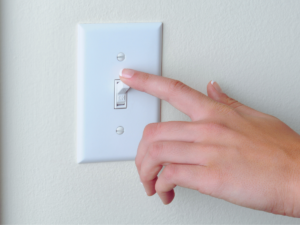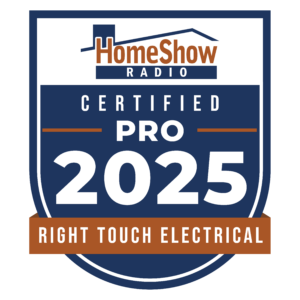 Light switches are simple. Flip up for light. Flip down for dark. That’s how it should work.
Light switches are simple. Flip up for light. Flip down for dark. That’s how it should work.
But over time, even these basic devices wear down. You might hear a pop, see a flicker, or notice nothing happens when you try to turn a light on.
While it may seem like a minor problem, a malfunctioning light switch can point to larger electrical issues. Loose wire connections, worn parts, or a short circuit can all cause a switch to stop doing its job. Ignoring it could lead to shocks, failed outlets, or even fires.
This article will show you what signs to look for, how electricians track down the source of the problem, and why it’s safer not to try fixing it yourself. You’ll also learn what else could be causing your light to stop working because not every issue comes from the switch.
Key Takeaways
- Strange sounds, sparks, or heat often mean it’s time to replace the switch.
- Flickering lights or delayed lighting can signal worn parts or bad wiring.
- Sometimes the problem isn’t the switch it’s the fixture or socket.
- Electricians use tools like multimeters and testers to find faults.
- DIY electrical repairs carry real risks. Hire a licensed professional.
Warning Signs of a Failing Light Switch
It’s easy to overlook small changes in how a switch works. But these early symptoms are how light switch problems start.
Strange Noises Coming From Switch
Clicking, popping, or snapping when flipping the switch is not normal. These noises often come from internal damage or electrical arcing. It’s a sign to replace the switch.
Delayed or Flickering Lights
If the lights flicker or take time to turn on, worn contacts or loose electrical wires might be the cause. In some cases, the light bulb or fixture itself may be faulty, but a bad switch is a common cause.
Sparks Coming From Switch
A tiny spark (called a load arc) can be normal when a switch closes a circuit. But large sparks, scorch marks, or any sign of smoke means danger. Turn off the power immediately and call a professional electrician.
Tripped Circuit Breakers
If flipping the switch causes a tripped circuit breaker, you may be dealing with a short circuit. A failing light switch can trigger this. If it happens more than once, don’t guess, get it checked out.
Light Fixture Issues
Some lights work only some of the time. That can mean the switch contacts are worn, or wiring has come loose. If replacing the switch doesn’t help, the fixture or socket may be the source of the problem.
Audible Buzzing or Sizzling
A light buzzing sound might come from dimmer switches using the wrong kind of bulb. But if you hear a buzz or sizzle from a regular switch, it likely means internal damage or loose wires. Test the bulb first. If it’s not the bulb, test the switch.
Warm or Hot Switch Cover Plate
Dimmer switches may feel slightly warm. That’s normal. But a standard toggle switch should stay cool. If it’s hot to the touch, there may be an overload or undersized switch handling too much current.
Cracked or Burned Switch Cover Plates
Physical damage like cracking or burn marks on the switch cover plate is more than cosmetic. It shows that something inside is breaking down. Turn off the power and replace the switch before it worsens.
When the Issue Isn’t the Switch
Sometimes the light switch is working fine. The real issue lies elsewhere in the system.
Faulty Light Socket
If power isn’t reaching the light socket, the switch won’t matter. A voltage tester can help confirm this. Light sockets are wired to carry current. Leave repairs to a licensed electrician.
Failing Ballast (in older or fluorescent fixtures)
Ballasts regulate current in certain lights. When they go bad, you’ll notice buzzing, delayed lighting, or scorch marks. Replacing a ballast involves wire splicing. It’s not a DIY task.
How Electricians Troubleshoot Light Switch Issues
 Professional electricians follow a structured process to find electrical problems. They rely on tools, training, and experience—not guesswork.
Professional electricians follow a structured process to find electrical problems. They rely on tools, training, and experience—not guesswork.
Circuit Breaker & Power Supply Check
First, they check for a tripped circuit breaker or blown fuse. If one’s tripped, they reset it. If the breaker keeps tripping, that’s a sign of a deeper problem.
Initial Inspection
They check the light bulb, socket, and switch for obvious signs of failure. If the bulb works in another socket, it’s likely the switch or wiring.
Removing the Switch Plate
With power turned off, the electrician removes the switch cover. Using a non-contact voltage tester, they check for live current. They also look for loose wires or visible damage.
Testing Wire Connections
They inspect every connection. Loose wires are common and dangerous. If they find one, they tighten it or use proper connectors to secure it.
Replacing the Switch
If the switch is faulty, they’ll remove the old one. After confirming the power is off, they wire in a new switch rated for the circuit.
Using a Multimeter or Continuity Tester
They measure resistance across terminals. A single-pole switch should show continuity when flipped on. Three-way switches require testing between common and traveler terminals. If the tester reads “OL” or a high value, the switch is faulty.
DIY Switch Repair Is Not Recommended
Replacing a switch may look easy, but there’s a reason electricians train for years. Mistakes like reversed polarity or mixing up hot and neutral wires can cause shocks or damage.
Permits, codes, and safe installation matter. You may not need one for every switch, but professionals know when it’s required. They also use tools that test electrical flow without taking guesses.
Light Switch Not Working in Houston, TX?
 Right Touch Electrical serves Houston, TX and nearby areas. If your light switch isn’t working, don’t wait. Get it checked by professionals who deliver quality with a master’s touch.
Right Touch Electrical serves Houston, TX and nearby areas. If your light switch isn’t working, don’t wait. Get it checked by professionals who deliver quality with a master’s touch.
Our team handles everything from faulty switches to full electrical troubleshooting. We’ll find the problem, fix it safely, and explain every step.
FAQs
If your light switch isn’t working, you’re not alone. Here are answers to common questions we hear.
Why did my light switch stop working suddenly?
It may be due to worn internal parts, a loose wire, or a tripped circuit breaker.
Is it safe to use a switch that sparks?
No. Large sparks or scorch marks are signs of trouble. Turn off the power and call an electrician.
Can I replace a light switch myself?
Technically, yes. But without proper tools and safety checks, it’s risky. A professional ensures it’s done right.
What tools do electricians use to test switches?
Voltage testers, continuity testers, and multimeters. These tools help them find where electrical flow is breaking down.
What if the light still doesn’t work after replacing the switch?
The problem may lie in the fixture, socket, or wiring. Further testing is needed.
How much does it cost to replace a light switch in Houston?
Costs vary by type of switch and labor. Most jobs are quick and affordable. Call Right Touch for an estimate.
Final Thoughts
A light switch that doesn’t work is more than a small annoyance. It can be a sign of larger electrical problems. Strange sounds, flickering lights, or heat from the switch are all signs to take seriously.
Don’t try to fix it yourself. Call a professional. If you’re in Houston, reach out to Right Touch Electrical for fast service and honest answers.
When it comes to electrical safety, small signs matter. Fixing a bad switch today may prevent a bigger problem tomorrow.
